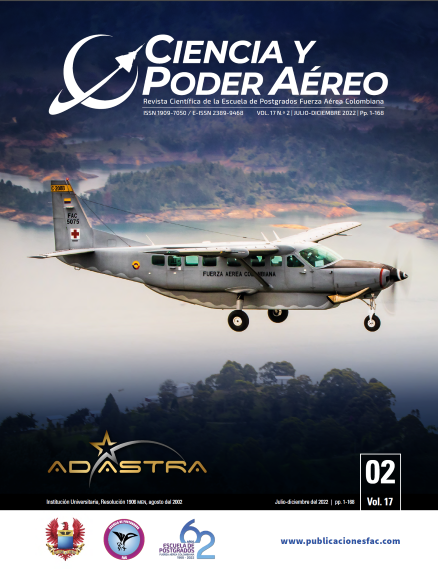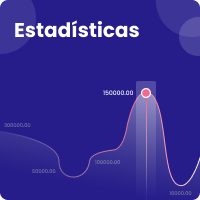Evaluación computacional del compartimiento de carga de una aeronave liviana, usando software libre
DOI:
https://doi.org/10.18667/cienciaypoderaereo.749Palabras clave:
Calculo estructural, dinámica computacional de fluidos (CFD), elementos finitos, software de código abierto, ultralivianoResumen
Este documento presenta la evaluación estructural del cuerpo de una aeronave ligera de categoría vla (masa máxima al despegue inferior o igual a 1200 kg), usando sofware de dinámica computacional de fluidos (CDF) para evaluar el comportamiento aerodinámico de la aeronave y el método de elementos finitos para evaluar su comportamiento estructural. Para su evaluación estructural la aeronave se dividió en cabina, cuerpo y superficies de vuelo (alas y empenaje). Los modelos completos de la aeronave fueron extraídos del modelo cad, elaborado con el sofware SolidWorks® para cada uno de los subcomponentes de la cabina, el cuerpo y las alas y el empenaje. A partir de los cálculos y simulaciones hechas, se concluyó que la estructura central de la aeronave soporta las fuerzas y momentos aerodinámicos, con valores de esfuerzos por debajo de los valores de fluencia del material y factores de seguridad entre 1.58 y 2.60. Sin embargo, se necesita reforzar la unión del ala al fuselaje para que disminuya el esfuerzo localizado que se produce en esa zona. A diferencia de otros métodos reportados en la literatura que utilizan programas muy especializados y de altos costos, el procedimiento para evaluar la aerodinámica y la estructura central de una aeronave liviana categoría VLA que se desarrolló en este estudio, hizo uso de programas de dominio público, en alrededor de 80 % en el proceso de análisis.
Descargas
Referencias
Aircraft Design: A Conceptual Approach, Sixth Edition. (n.d.). AIAA Education Series. Retrieved March 7, 2022, from https://arc.aiaa.org/doi/abs/10.2514/4.104909
Albadr, A., Hedaya, M., McCrory, J., & Holford, K. (2019). Parametric study of honeycomb composite structure using open source finite element software. https://www.researchgate.net/publication/332383984_Parametric_Study_of_Honeycomb_Composite_Structure_Using_Open_Source_Finite_Element_Software
ASM Material Data Sheet. (n.d.). Retrieved March 3, 2022, from http://asm.matweb.com/search/SpecificMaterial.asp?bassnum=ma6061t6
Bojita, A., Avram, A., Purcar, M., Munteanu, C., & Topa, V. (2017). Thermo-mechanical simulation of the metal-semiconductor structures of power integrated circuits. 2017 International Conference on Modern Power Systems (MPS), 1–6. https://doi.org/10.1109/MPS.2017.7974450
CALCULIX: A Three-Dimensional Structural Finite Elemente Program. (n.d.). Retrieved February 16, 2021, from http://www.calculix.de/
Camara, A. B., Pennec, F., Durif, S., Robert, J.-L., & Bouchaïr, A. (2018). Fatigue life assessment of bolted connections. MATEC Web of Conferences, 165, 10009. https://doi.org/10.1051/matecconf/201816510009
Deák, P. (2018). Vertical tail FEA with a CAD/CAE based multidisciplinary process. Aircraft Engineering and Aerospace Technology, 90(4), 652–658. https://doi.org/10.1108/AEAT-11-2016-0212
Elmer FEM – open source multiphysical simulation software. (n.d.). Retrieved February 16, 2021, from http://www.elmerfem.org/blog/
Elmer—Elmer—CSC Company Site. (n.d.). Retrieved February 16, 2021, from https://www.csc.fi/web/elmer
Gagliardini, O., Zwinger, T., Gillet-Chaulet, F., Durand, G., Favier, L., de Fleurian, B., Greve, R., Malinen, M., Martín, C., Råback, P., Ruokolainen, J., Sacchettini, M., Schäfer, M., Seddik, H., & Thies, J. (2013). Capabilities and performance of Elmer/Ice, a new-generation ice sheet model. Geoscientific Model Development, 6(4), 1299–1318. https://doi.org/10.5194/gmd-6-1299-2013
Galeano Urueña, C. H., Mantilla González, J. M., Duque Daza, C. A., & Mejía de Alba, M. F. (2019). Herramientas de software con licencia pública general para el modelado por elementos finitos. https://repositorio.unal.edu.co/handle/unal/22434
Geuzaine, C. & Remacle, J. F. (2009). gmsh: A three-dimensional finite element mesh generator with built-in pre- and post-processing facilities. https://gmsh.info/
General Public License «gpl». (2020). Término General Public License. Wikipedia, la enciclopedia libre. https://es.wikipedia.org/w/index.php?itle=GNU_General_Public_License&oldid=129620200
Grote, K. H. & Antonsson, E. K. (2009). Springer Handbook of Mechanical Engineering. https://link.springer.com/book/10.1007/978-3-540-30738-9
Jaramillo, H. E., & Areiza, G. (2000). Algunas generalidades sobre el modelado de secciones compuestas usando elementos finitos. Revista Scientia et Technica, Edición, 13.
Jaramillo, H. E., García, A., Gómez, L., Escobar, W., & García, J. J. (2012). Procedimiento para generar mallas de elementos finitos de la columna vertebral humana a partir de imágenes médicas. Revista el Hombre y la Máquina, 40, 79–86.
Johnson, F., Tinoco, E., & Yu, N. (2005). Thirty Years of Development and Application of CFD at Boeing Commercial Airplanes, Seattle. Computers & Fluids, 34, 1115–1151. https://doi.org/10.1016/j.compfluid.2004.06.005
Kallemeyn, N. A., Tadepalli, S. C., Shivanna, K. H., & Grosland, N. M. (2009). An interactive multiblock approach to meshing the spine. Computer Methods and Programs in Biomedicine, 95(3), 227–235. https://doi.org/10.1016/j.cmpb.2009.03.005
Kiani, M., Wang, G., Ye, Z., & Mian, H. H. (2015). Aerodynamic and Static Aeroelastic Analysis of a Transonic Wing using Hybrid Unstructured Flow Solver. https://doi.org/10.15242/iie.e1214053
Kumaresan, S., Yoganandan, N., Pintar, F. A., & Maiman, D. J. (1999). Finite element modeling of the cervical spine: Role of intervertebral disc under axial and eccentric loads. Medical Engineering & Physics, 21(10), 689–700. https://doi.org/10.1016/S1350-4533(00)00002-3
Kundu, A. K. (2010). Aircraft Design.
Menter, F. R. (1992). Influence of freestream values on k-omega turbulence model predictions. AIAA Journal, 30(6), 1657–1659. https://doi.org/10.2514/3.11115
MIMICS Financial Software. (n.d.). Retrieved February 5, 2021, from https://www.mimics.com/
Nammi, S. K., Butt, J., Mauricette, J.-L., & Shirvani, H. (2017). Numerical Analysis of Thermal Stresses around Fasteners in Composite Metal Foils. IOP Conference Series: Materials Science and Engineering, 280, 012016. https://doi.org/10.1088/1757-899X/280/1/012016
Nemchinov, S., & Khristenko, A. (2018). Stress-strain state of pneumatic flexible shaft coupling for ball mill drives. Zeszyty Naukowe. Transport / Politechnika Śląska, z. 99. https://doi.org/10.20858/sjsutst.2018.99.12
OpenFOAM. (n.d.). Retrieved September 27, 2021, from https://www.openfoam.com/
PANUKL / Software / Teaching / ADD / Strona główna—ADD. (n.d.). Retrieved March 3, 2022, from https://www.meil.pw.edu.pl/add/ADD/Teaching/Software/PANUKL
Park, C., Joh, C. Y. & Kim, Y. S. (2009). Multidisciplinary design optimization of a structurally nonlinear aircraf wing via parametric modeling. International Journal of Precision Engineering and Manufacturing, 10(2), 87–96. https://doi.org/10.1007/s12541-009-0032-1
Qiu, J., Fan, Y., Wei, H. & Zhang, P. (2021). Lightweight design of aircraf truss based on topology and size optimization. Journal of Physics: Conference Series, 1986(1), 012094. https://doi.org/10.1088/1742-6596/1986/1/012094
Roskam, J. (2017). Airplane Design Part III: Layout Design of Cockpit, Fuselage, Wing and Empennage: Cutaways and Inboard Profiles.
Růžička, P. (2018). Modeling of boundary layer and the influence on heat transfer with help of cfd. aip Conference Proceedings, 2047(1), 020021. https://doi.org/10.1063/1.5081654
Safinowski, M., Szudarek, M., Szewczyk, R. & Winiarski, W. (2017). Capabilities of an Open-Source Software, Elmer fem, in Finite Element Analysis of Fluid Flow. In R.
Szewczyk & M. Kaliczyńska (Eds.), Recent Advances in Systems, Control and Information Technology (pp. 118–126). Springer International Publishing. https://doi.org/10.1007/978-3-319-48923-0_16
Salome-Meca - Code_Aster. (2022). lgpl binary packages. https://www.code-aster.org/V2/spip.php?article303
Seo, D.-W., Kim, J.-S., & Kim, M.-I. (2017). Pre/Post processor for structural analysis simulation integration with open source solver (Calculix, Code_Aster). Journal of the Korea Academia-Industrial cooperation Society, 18(9), 425–435. https://doi.org/10.5762/KAIS.2017.18.9.425
Takala, E., Yurtesen, E., Westerholm, J., Ruokolainen, J., & Råback, P. (2016). Parallel Simulations of Inductive Components with Elmer Finite-Element Software in Cluster Environments. Electromagnetics, 36(3), 167–185. https://doi.org/10.1080/02726343.2016.1151616
Triet, N. M., Viet, N. N. & Thang, P. M. (2015). Aerodynamic Analysis of Aircraf Wing. VNU Journal of Science: Mathematics - Physics, 31(2), Article 2. https://js.vnu.edu.vn/MaP/article/view/111
Tyndyka, M. A., Barron, V., McHugh, P. E., & O’Mahoney, D. (2007). Generation of a finite element model of the thoracolumbar spine. Acta of Bioengineering and Biomechanics, 9(1), 35–46.
Wu, Z., Li, S., Liu, M., Wang, S., Yang, H. & Liang, X. (2019). Numerical research on the turbulent drag reduction mechanism of a transverse groove structure on an airfoil
blade. Engineering Applications of Computational Fluid Mechanics, 13(1), 1024–1035. https://doi.org/10.1080/19942060.2019.1665101
Yapor Genao. (2018). Multi-Scale Analysis of Composite Materials Using Calculix and the Method of Cells: An Open Source Implementation. Master’s Theses. https://scholarworks.wmich.edu/masters_theses/3795
Ye, K., Ye, Z., Feng, Z., Pan, Y., & Wang, G. (2019). Numerical investigation on the aerothermoelastic deformation of the hypersonic wing. Acta Astronautica, 160, 76–89. https://doi.org/10.1016/j.actaastro.2019.04.028
Publicado
Número
Sección
Licencia
Derechos de autor 2022 Escuela de Postgrados de la Fuerza Aérea Colombiana

Esta obra está bajo una licencia internacional Creative Commons Atribución 4.0.
Declaración de cesión de los derechos de autor a la revista
Los autores ceden la Revista los derechos de explotación (reproducción, distribución, comunicación pública y transformación) para explotar y comercializar la obra, entera o en parte, en todos los formatos y modalidades de explotación presentes o futuros, en todos los idiomas, por todo el periodo de vida de la obra y por todo el mundo.
Todos los contenidos publicados en la revista científica Ciencia y Poder Aéreo están sujetos a la licencia reconocimiento 4.0 Internacional de Creative Commons, cuyo texto completo se puede consultar en http://creativecommons.org/licenses/by/4.0/
La licencia permite a cualquier usuario descargar, imprimir, extraer, archivar, distribuir y comunicar públicamente este artículo, siempre y cuando el crédito se dé a los autores de la obra: a los autores del texto y a Ciencia y Poder Aéreo, Revista Científica de la Escuela de Postgrados de la Fuerza Aérea Colombiana. Excepto cuando se indique lo contrario, el contenido en este sitio es licenciado bajo una licencia Creative Commons Atribución 4.0 internacional.
Para usos de los contenidos no previstos en estas normas de publicación es necesario contactar directamente con el director o editor de la revista a través del correo cienciaypoderaereo@epfac.edu.
La Escuela de Postgrados de la Fuerza Aérea Colombiana y esta publicación no son responsables de los conceptos emitidos en los artículos, ni de los metadatos aportados ni de las filiaciones que los autores declaren, ya que esta es responsabilidad plena de los autores.

Licencia Creative Commons
Cómo citar
Datos de los fondos
-
Sistema General de Regalías de Colombia
Números de la subvención Proyecto: “Investigación y Desarrollo en el Sector Aeronáutico del Valle del Cauca”, BPIN 20170010043





















